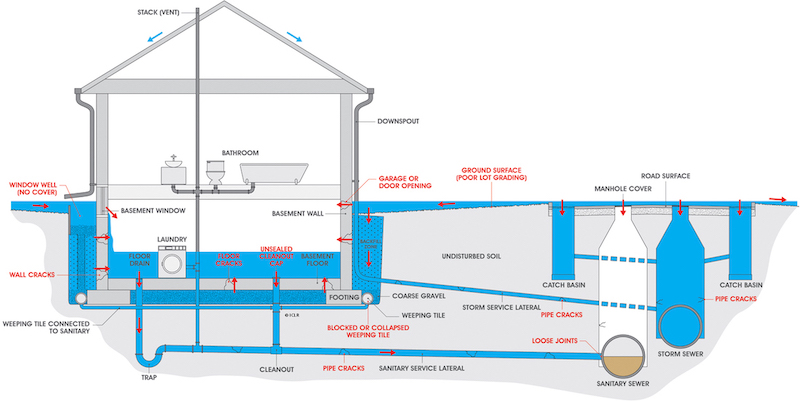
Basement Flooding Prevention
If your basement is flooding, most likely water pressure was building-up around your foundation. Water naturally seeks the path of least resistance and enters through cracks in your walls or floors. The result…a wet basement.
If it stays wet you may see unhealthy black mold growing. Sump pumps usually are a great solution. Basement waterproofing or drain tile repair may also be an answer.
“But I have a sump pump that works except during heavy rains. Plumbers have showed up and recommended a new sump pump or a larger sump pump, but the symptom remains: too much water. What else can cause my basement flooding?”
Over 100 years we’ve seen a lot of flooding problems. Sometimes a back-up sump pump is needed to handle the added volume of water. But excessive flooding could also be caused by two other problems: drain-tiles and water run-off.
Drain-Tile, Weeping Tile or Footing Drains
Pipes placed around your home’s foundation, maybe 12″ to 18″ below your basement floor depth.
Drain-tile collects groundwater during rainfall or when your garden beds are irrigated. On older homes, groundwater trickles to the drain-tile entering a clay tile at the joint. Newer homes use plastic perforated PVC drainage tubing or pipe.
Blocked Drain-Tiles
From time to time, especially after many years of use, drain-tile can crack or become plugged with debris. Downspouts connected directly to the drain-tile will sometimes carry sediment and rotting leaves which have landed on the roof. Soils can also build up in the drain-tile.
The consequence of non functioning drain-tiles might be water seeping through the porous concrete foundation or leaving a damp mark on the basement floor or foundation wall or more serious flooding. The vast majority of blocked drain-tile repairs calls for the excavation and replacement of the clogged section.
Water Run-Off: Grading Problem
Do you notice your landscape or property grade allows water to flow towards your home rather than away? Heavy rains could be overwhelming your drain-tiles and sump pump capacity which means basement flooding. Your solution can involve building up soil around your home or grading your land to force rain water away from your home. The less water around your home the better.
Call The Area’s Oldest Plumber For Basement Flooding Advice
Let a plumber with a 139 year track record find the right drainage solutions to keep you dry. Contact PDM Plumbing, Heating & Cooling Since 1885. Serving Joliet SW Chicago suburbs. Call 815-390-7095 .






